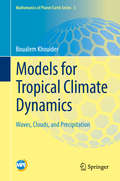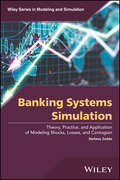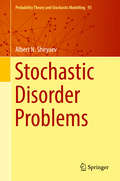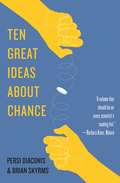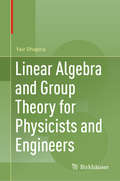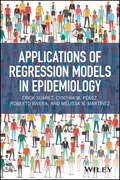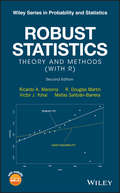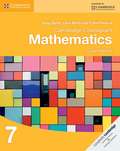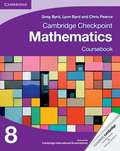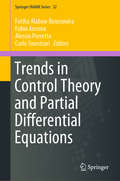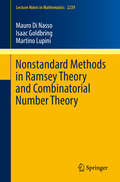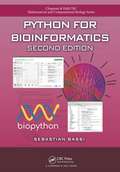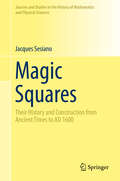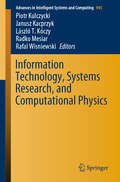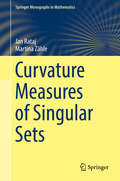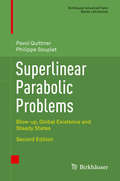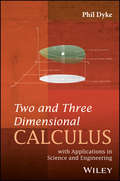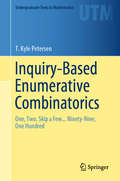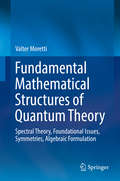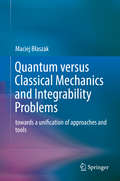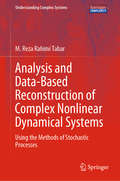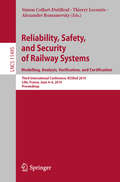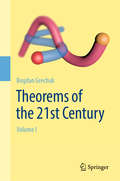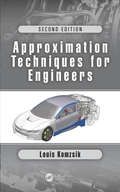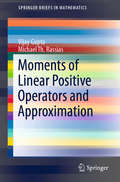- Table View
- List View
Models for Tropical Climate Dynamics: Waves, Clouds, and Precipitation (Mathematics of Planet Earth #3)
by Boualem KhouiderThis book is a survey of the research work done by the author over the last 15 years, in collaboration with various eminent mathematicians and climate scientists on the subject of tropical convection and convectively coupled waves. In the areas of climate modelling and climate change science, tropical dynamics and tropical rainfall are among the biggest uncertainties of future projections. This not only puts at risk billions of human beings who populate the tropical continents but it is also of central importance for climate predictions on the global scale. This book aims to introduce the non-expert readers in mathematics and theoretical physics to this fascinating topic in order to attract interest into this difficult and exciting research area. The general thyme revolves around the use of new deterministic and stochastic multi-cloud models for tropical convection and convectively coupled waves. It draws modelling ideas from various areas of mathematics and physics and used in conjunction with state-of-the-art satellite and in-situ observations and detailed numerical simulations. After a review of preliminary material on tropical dynamics and moist thermodynamics, including recent discoveries based on satellite observations as well as Markov chains, the book immerses the reader into the area of models for convection and tropical waves. It begins with basic concepts of linear stability analysis and ends with the use of these models to improve the state-of-the-art global climate models. The book also contains a fair amount of exercises that makes it suitable as a textbook complement on the subject.
Banking Systems Simulation: Theory, Practice, and Application of Modeling Shocks, Losses, and Contagion (Wiley Series in Modeling and Simulation)
by Stefano ZeddaPresents information sources and methodologies for modeling and simulating banking system stability Combining both academic and institutional knowledge and experience, Banking Systems Simulation: Theory, Practice, and Application of Modeling Shocks, Losses, and Contagion presents banking system risk modeling clearly within a theoretical framework. Written from the global financial perspective, the book explores single bank risk, common bank exposures, and contagion, and how these apply on a systemic level. Zedda approaches these simulation methods logically by providing the basic building blocks of modeling and simulation, and then delving further into the individual techniques that make up a systems model. In addition, the author provides clear and detailed explanations of the foundational research into the mathematical and legal concepts used to analyze banking risk problems, measures and data for representing the main banking risk sources, and the major problems researchers are likely to encounter. There are numerous software descriptions throughout, with references and tools to help readers gain a proper understanding of the presented techniques and possibly develop new applications and research. The book concludes with an appendix that features real-world datasets and models. In addition, this book: • Provides a comprehensive overview of methods for analyzing models and simulating risk for banking and financial systems • Provides a clear presentation of the technical and legal concepts used in banking regulation • Presents unique insights from an expert’s perspective, with specific coverage of assessing risks and developing what-if analyses at the systems level • Concludes with a discussion of applications, including banking systems regulation what-if tests, cost-benefit analysis, evaluations of banking systems stability effects on public finances, dimensioning, and risk-based contributions for Deposit Guarantee Schemes (DGS) and Resolution Funds Banking Systems Simulation: Theory, Practice, and Application of Modeling Shocks, Losses, and Contagion is ideal for banking researchers focusing on computational methods of analysis as well as an appropriate reference for graduate-level students in banking, finance, and computational methods. Stefano Zedda is Researcher in Financial Mathematics at the University of Cagliari in Italy and qualified as associate professor in banking and corporate finance. His research is mainly focused on quantitative analyses for banking and finance, with a particular focus on banking systems modeling and simulation. In 2008, Zedda developed the mathematical modeling and software implementation of the Systemic Model for Banking Originated Losses (SYMBOL), further developed during his activity at the European Commission. The Commission subsequently adopted it as a standard tool for testing banking regulation proposals. Stefano Zedda’s research interests include banking, financial mathematics, and statistics, specifically simulation of banking and financial systems stability, banking regulation impact assessment, and interactive agent simulation.
Stochastic Disorder Problems (Probability Theory and Stochastic Modelling #93)
by Albert N. ShiryaevThis monograph focuses on those stochastic quickest detection tasks in disorder problems that arise in the dynamical analysis of statistical data. These include quickest detection of randomly appearing targets, of spontaneously arising effects, and of arbitrage (in financial mathematics). There is also currently great interest in quickest detection methods for randomly occurring intrusions in information systems and in the design of defense methods against cyber-attacks. The author shows that the majority of quickest detection problems can be reformulated as optimal stopping problems where the stopping time is the moment the occurrence of disorder is signaled. Thus, considerable attention is devoted to the general theory of optimal stopping rules, and to its concrete problem-solving methods.The exposition covers both the discrete time case, which is in principle relatively simple and allows step-by-step considerations, and the continuous-time case, which often requires more technical machinery such as martingales, supermartingales, and stochastic integrals. There is a focus on the well-developed apparatus of Brownian motion, which enables the exact solution of many problems. The last chapter presents applications to financial markets.Researchers and graduate students interested in probability, decision theory and statistical sequential analysis will find this book useful.
Ten Great Ideas about Chance
by Persi Diaconis Brian SkyrmsA fascinating account of the breakthrough ideas that transformed probability and statisticsIn the sixteenth and seventeenth centuries, gamblers and mathematicians transformed the idea of chance from a mystery into the discipline of probability, setting the stage for a series of breakthroughs that enabled or transformed innumerable fields, from gambling, mathematics, statistics, economics, and finance to physics and computer science. This book tells the story of ten great ideas about chance and the thinkers who developed them, tracing the philosophical implications of these ideas as well as their mathematical impact.Persi Diaconis and Brian Skyrms begin with Gerolamo Cardano, a sixteenth-century physician, mathematician, and professional gambler who helped develop the idea that chance actually can be measured. They describe how later thinkers showed how the judgment of chance also can be measured, how frequency is related to chance, and how chance, judgment, and frequency could be unified. Diaconis and Skyrms explain how Thomas Bayes laid the foundation of modern statistics, and they explore David Hume’s problem of induction, Andrey Kolmogorov’s general mathematical framework for probability, the application of computability to chance, and why chance is essential to modern physics. A final idea—that we are psychologically predisposed to error when judging chance—is taken up through the work of Daniel Kahneman and Amos Tversky.Complete with a brief probability refresher, Ten Great Ideas about Chance is certain to be a hit with anyone who wants to understand the secrets of probability and how they were discovered.
Linear Algebra and Group Theory for Physicists and Engineers
by Yair ShapiraThis textbook demonstrates the strong interconnections between linear algebra and group theory by presenting them simultaneously, a pedagogical strategy ideal for an interdisciplinary audience. Being approached together at the same time, these two topics complete one another, allowing students to attain a deeper understanding of both subjects. The opening chapters introduce linear algebra with applications to mechanics and statistics, followed by group theory with applications to projective geometry. Then, high-order finite elements are presented to design a regular mesh and assemble the stiffness and mass matrices in advanced applications in quantum chemistry and general relativity.This text is ideal for undergraduates majoring in engineering, physics, chemistry, computer science, or applied mathematics. It is mostly self-contained—readers should only be familiar with elementary calculus. There are numerous exercises, with hints or full solutions provided. A series of roadmaps are also provided to help instructors choose the optimal teaching approach for their discipline.
Applications of Regression Models in Epidemiology
by Erick Suárez Cynthia M. Pérez Roberto Rivera Melissa N. MartínezA one-stop guide for public health students and practitioners learning the applications of classical regression models in epidemiology This book is written for public health professionals and students interested in applying regression models in the field of epidemiology. The academic material is usually covered in public health courses including (i) Applied Regression Analysis, (ii) Advanced Epidemiology, and (iii) Statistical Computing. The book is composed of 13 chapters, including an introduction chapter that covers basic concepts of statistics and probability. Among the topics covered are linear regression model, polynomial regression model, weighted least squares, methods for selecting the best regression equation, and generalized linear models and their applications to different epidemiological study designs. An example is provided in each chapter that applies the theoretical aspects presented in that chapter. In addition, exercises are included and the final chapter is devoted to the solutions of these academic exercises with answers in all of the major statistical software packages, including STATA, SAS, SPSS, and R. It is assumed that readers of this book have a basic course in biostatistics, epidemiology, and introductory calculus. The book will be of interest to anyone looking to understand the statistical fundamentals to support quantitative research in public health. In addition, this book: • Is based on the authors’ course notes from 20 years teaching regression modeling in public health courses • Provides exercises at the end of each chapter • Contains a solutions chapter with answers in STATA, SAS, SPSS, and R • Provides real-world public health applications of the theoretical aspects contained in the chapters Applications of Regression Models in Epidemiology is a reference for graduate students in public health and public health practitioners. ERICK SUÁREZ is a Professor of the Department of Biostatistics and Epidemiology at the University of Puerto Rico School of Public Health. He received a Ph.D. degree in Medical Statistics from the London School of Hygiene and Tropical Medicine. He has 29 years of experience teaching biostatistics. CYNTHIA M. PÉREZ is a Professor of the Department of Biostatistics and Epidemiology at the University of Puerto Rico School of Public Health. She received an M.S. degree in Statistics and a Ph.D. degree in Epidemiology from Purdue University. She has 22 years of experience teaching epidemiology and biostatistics. ROBERTO RIVERA is an Associate Professor at the College of Business at the University of Puerto Rico at Mayaguez. He received a Ph.D. degree in Statistics from the University of California in Santa Barbara. He has more than five years of experience teaching statistics courses at the undergraduate and graduate levels. MELISSA N. MARTÍNEZ is an Account Supervisor at Havas Media International. She holds an MPH in Biostatistics from the University of Puerto Rico and an MSBA from the National University in San Diego, California. For the past seven years, she has been performing analyses for the biomedical research and media advertising fields.
Robust Statistics: Theory and Methods (with R) (Wiley Series in Probability and Statistics)
by Ricardo A. Maronna R. Douglas Martin Victor J. Yohai Matías Salibián-BarreraA new edition of this popular text on robust statistics, thoroughly updated to include new and improved methods and focus on implementation of methodology using the increasingly popular open-source software R. Classical statistics fail to cope well with outliers associated with deviations from standard distributions. Robust statistical methods take into account these deviations when estimating the parameters of parametric models, thus increasing the reliability of fitted models and associated inference. This new, second edition of Robust Statistics: Theory and Methods (with R) presents a broad coverage of the theory of robust statistics that is integrated with computing methods and applications. Updated to include important new research results of the last decade and focus on the use of the popular software package R, it features in-depth coverage of the key methodology, including regression, multivariate analysis, and time series modeling. The book is illustrated throughout by a range of examples and applications that are supported by a companion website featuring data sets and R code that allow the reader to reproduce the examples given in the book. Unlike other books on the market, Robust Statistics: Theory and Methods (with R) offers the most comprehensive, definitive, and up-to-date treatment of the subject. It features chapters on estimating location and scale; measuring robustness; linear regression with fixed and with random predictors; multivariate analysis; generalized linear models; time series; numerical algorithms; and asymptotic theory of M-estimates. Explains both the use and theoretical justification of robust methods Guides readers in selecting and using the most appropriate robust methods for their problems Features computational algorithms for the core methods Robust statistics research results of the last decade included in this 2nd edition include: fast deterministic robust regression, finite-sample robustness, robust regularized regression, robust location and scatter estimation with missing data, robust estimation with independent outliers in variables, and robust mixed linear models. Robust Statistics aims to stimulate the use of robust methods as a powerful tool to increase the reliability and accuracy of statistical modelling and data analysis. It is an ideal resource for researchers, practitioners, and graduate students in statistics, engineering, computer science, and physical and social sciences.
Cambridge Checkpoint Mathematics Coursebook 7 (PDF)
by Greg Byrd Lynn Byrd Chris PearceWritten by well-respected authors, the Cambridge Checkpoint Mathematics suite provides a comprehensive structured resource which covers the full Cambridge Secondary 1 Mathematics framework in three stages. This brightly illustrated Coursebook for Stage 7 offers a comprehensive introduction to all topics covered in the syllabus. Worked examples show students how to tackle different problems, and plenty of exercise questions prepare students for the different types of question they will face in their exam. Coverage of the Problem Solving framework is integrated throughout the course, with questions relating to the framework statements highlighted in the Coursebook and Practice Book.
Cambridge Checkpoint Mathematics Coursebook 8 (PDF)
by Greg Byrd Lynn Byrd Chris PearceWritten by well-respected authors, the Cambridge Checkpoint Mathematics suite provides a comprehensive structured resource which covers the full Cambridge Secondary 1 Mathematics framework in three stages. This brightly illustrated Coursebook for Stage 8 offers a comprehensive introduction to all topics covered in the syllabus. Worked examples show students how to tackle different problems, and plenty of exercise questions prepare students for the different types of questions they will face in their Progression test. Coverage of the Problem Solving framework is integrated throughout the course, with questions relating to the Problem Solving framework statements highlighted in the Coursebook.
Trends in Control Theory and Partial Differential Equations (Springer INdAM Series #32)
by Fatiha Alabau-Boussouira Fabio Ancona Alessio Porretta Carlo SinestrariThis book presents cutting-edge contributions in the areas of control theory and partial differential equations. Over the decades, control theory has had deep and fruitful interactions with the theory of partial differential equations (PDEs). Well-known examples are the study of the generalized solutions of Hamilton-Jacobi-Bellman equations arising in deterministic and stochastic optimal control and the development of modern analytical tools to study the controllability of infinite dimensional systems governed by PDEs. In the present volume, leading experts provide an up-to-date overview of the connections between these two vast fields of mathematics. Topics addressed include regularity of the value function associated to finite dimensional control systems, controllability and observability for PDEs, and asymptotic analysis of multiagent systems. The book will be of interest for both researchers and graduate students working in these areas.
Nonstandard Methods in Ramsey Theory and Combinatorial Number Theory (Lecture Notes in Mathematics #2239)
by Martino Lupini Isaac Goldbring Mauro Di NassoThe goal of this monograph is to give an accessible introduction to nonstandard methods and their applications, with an emphasis on combinatorics and Ramsey theory. It includes both new nonstandard proofs of classical results and recent developments initially obtained in the nonstandard setting. This makes it the first combinatorics-focused account of nonstandard methods to be aimed at a general (graduate-level) mathematical audience. This book will provide a natural starting point for researchers interested in approaching the rapidly growing literature on combinatorial results obtained via nonstandard methods. The primary audience consists of graduate students and specialists in logic and combinatorics who wish to pursue research at the interface between these areas.
Python for Bioinformatics (Chapman & Hall/CRC Mathematical and Computational Biology)
by Sebastian BassiIn today's data driven biology, programming knowledge is essential in turning ideas into testable hypothesis. Based on the author’s extensive experience, Python for Bioinformatics, Second Edition helps biologists get to grips with the basics of software development. Requiring no prior knowledge of programming-related concepts, the book focuses on the easy-to-use, yet powerful, Python computer language. This new edition is updated throughout to Python 3 and is designed not just to help scientists master the basics, but to do more in less time and in a reproducible way. New developments added in this edition include NoSQL databases, the Anaconda Python distribution, graphical libraries like Bokeh, and the use of Github for collaborative development.
Magic Squares: Their History and Construction from Ancient Times to AD 1600 (Sources and Studies in the History of Mathematics and Physical Sciences)
by Jacques SesianoThe science of magic squares witnessed an important development in the Islamic world during the Middle Ages, with a great variety of construction methods being created and ameliorated. The initial step was the translation, in the ninth century, of an anonymous Greek text containing the description of certain highly developed arrangements, no doubt the culmination of ancient research on magic squares.
Information Technology, Systems Research, and Computational Physics (Advances in Intelligent Systems and Computing #945)
by Piotr Kulczycki Janusz Kacprzyk László T. Kóczy Radko Mesiar Rafal WisniewskiThis book highlights a broad range of modern information technology tools, techniques, investigations and open challenges, mainly with applications in systems research and computational physics. Divided into three major sections, it begins by presenting specialized calculation methods in the framework of data analysis and intelligent computing. In turn, the second section focuses on application aspects, mainly for systems research, while the final section investigates how various tasks in the basic disciplines—mathematics and physics—can be tackled with the aid of contemporary IT methods. The book gathers selected presentations from the 3rd Conference on Information Technology, Systems Research and Computational Physics (ITSRCP'18), which took place on 2–5 July 2018 in Krakow, Poland. The intended readership includes interdisciplinary scientists and practitioners pursuing research at the interfaces of information technology, systems research, and computational physics.
Curvature Measures of Singular Sets (Springer Monographs in Mathematics)
by Jan Rataj Martina ZähleThe book describes how curvature measures can be introduced for certain classes of sets with singularities in Euclidean spaces. Its focus lies on sets with positive reach and some extensions, which include the classical polyconvex sets and piecewise smooth submanifolds as special cases. The measures under consideration form a complete system of certain Euclidean invariants. Techniques of geometric measure theory, in particular, rectifiable currents are applied, and some important integral-geometric formulas are derived. Moreover, an approach to curvatures for a class of fractals is presented, which uses approximation by the rescaled curvature measures of small neighborhoods. The book collects results published during the last few decades in a nearly comprehensive way.
Superlinear Parabolic Problems: Blow-up, Global Existence and Steady States (Birkhäuser Advanced Texts Basler Lehrbücher)
by Prof. Dr. Quittner Prof. Dr. SoupletThis book is devoted to the qualitative study of solutions of superlinear elliptic and parabolic partial differential equations and systems. This class of problems contains, in particular, a number of reaction-diffusion systems which arise in various mathematical models, especially in chemistry, physics and biology.The first two chapters introduce to the field and enable the reader to get acquainted with the main ideas by studying simple model problems, respectively of elliptic and parabolic type. The subsequent three chapters are devoted to problems with more complex structure; namely, elliptic and parabolic systems, equations with gradient depending nonlinearities, and nonlocal equations. They include many developments which reflect several aspects of current research. Although the techniques introduced in the first two chapters provide efficient tools to attack some aspects of these problems, they often display new phenomena and specifically different behaviors, whose study requires new ideas. Many open problems are mentioned and commented.The book is self-contained and up-to-date, it has a high didactic quality. It is devoted to problems that are intensively studied but have not been treated so far in depth in the book literature. The intended audience includes graduate and postgraduate students and researchers working in the field of partial differential equations and applied mathematics.The first edition of this book has become one of the standard references in the field. This second edition provides a revised text and contains a number of updates reflecting significant recent advances that have appeared in this growing field since the first edition.
Two and Three Dimensional Calculus: with Applications in Science and Engineering
by Phil DykeCovers multivariable calculus, starting from the basics and leading up to the three theorems of Green, Gauss, and Stokes, but always with an eye on practical applications. Written for a wide spectrum of undergraduate students by an experienced author, this book provides a very practical approach to advanced calculus—starting from the basics and leading up to the theorems of Green, Gauss, and Stokes. It explains, clearly and concisely, partial differentiation, multiple integration, vectors and vector calculus, and provides end-of-chapter exercises along with their solutions to aid the readers’ understanding. Written in an approachable style and filled with numerous illustrative examples throughout, Two and Three Dimensional Calculus: with Applications in Science and Engineering assumes no prior knowledge of partial differentiation or vectors and explains difficult concepts with easy to follow examples. Rather than concentrating on mathematical structures, the book describes the development of techniques through their use in science and engineering so that students acquire skills that enable them to be used in a wide variety of practical situations. It also has enough rigor to enable those who wish to investigate the more mathematical generalizations found in most mathematics degrees to do so. Assumes no prior knowledge of partial differentiation, multiple integration or vectors Includes easy-to-follow examples throughout to help explain difficult concepts Features end-of-chapter exercises with solutions to exercises in the book. Two and Three Dimensional Calculus: with Applications in Science and Engineering is an ideal textbook for undergraduate students of engineering and applied sciences as well as those needing to use these methods for real problems in industry and commerce.
Inquiry-Based Enumerative Combinatorics: One, Two, Skip a Few... Ninety-Nine, One Hundred (Undergraduate Texts in Mathematics)
by T. Kyle PetersenThis textbook offers the opportunity to create a uniquely engaging combinatorics classroom by embracing Inquiry-Based Learning (IBL) techniques. Readers are provided with a carefully chosen progression of theorems to prove and problems to actively solve. Students will feel a sense of accomplishment as their collective inquiry traces a path from the basics to important generating function techniques.Beginning with an exploration of permutations and combinations that culminates in the Binomial Theorem, the text goes on to guide the study of ordinary and exponential generating functions. These tools underpin the in-depth study of Eulerian, Catalan, and Narayana numbers that follows, and a selection of advanced topics that includes applications to probability and number theory. Throughout, the theory unfolds via over 150 carefully selected problems for students to solve, many of which connect to state-of-the-art research.Inquiry-Based Enumerative Combinatorics is ideal for lower-division undergraduate students majoring in math or computer science, as there are no formal mathematics prerequisites. Because it includes many connections to recent research, students of any level who are interested in combinatorics will also find this a valuable resource.
Fundamental Mathematical Structures of Quantum Theory: Spectral Theory, Foundational Issues, Symmetries, Algebraic Formulation
by Valter MorettiThis textbook presents in a concise and self-contained way the advanced fundamental mathematical structures in quantum theory. It is based on lectures prepared for a 6 months course for MSc students. The reader is introduced to the beautiful interconnection between logic, lattice theory, general probability theory, and general spectral theory including the basic theory of von Neumann algebras and of the algebraic formulation, naturally arising in the study of the mathematical machinery of quantum theories. Some general results concerning hidden-variable interpretations of QM such as Gleason's and the Kochen-Specker theorems and the related notions of realism and non-contextuality are carefully discussed. This is done also in relation with the famous Bell (BCHSH) inequality concerning local causality.Written in a didactic style, this book includes many examples and solved exercises.The work is organized as follows. Chapter 1 reviews some elementary facts and properties of quantum systems. Chapter 2 and 3 present the main results of spectral analysis in complex Hilbert spaces. Chapter 4 introduces the point of view of the orthomodular lattices' theory. Quantum theory form this perspective turns out to the probability measure theory on the non-Boolean lattice of elementary observables and Gleason's theorem characterizes all these measures. Chapter 5 deals with some philosophical and interpretative aspects of quantum theory like hidden-variable formulations of QM. The Kochen-Specker theorem and its implications are analyzed also in relation BCHSH inequality, entanglement, realism, locality, and non-contextuality. Chapter 6 focuses on the algebra of observables also in the presence of superselection rules introducing the notion of von Neumann algebra. Chapter 7 offers the idea of (groups of) quantum symmetry, in particular, illustrated in terms of Wigner and Kadison theorems. Chapter 8 deals with the elementary ideas and results of the so called algebraic formulation of quantum theories in terms of both *-algebras and C*-algebras.This book should appeal to a dual readership: on one hand mathematicians that wish to acquire the tools that unlock the physical aspects of quantum theories; on the other physicists eager to solidify their understanding of the mathematical scaffolding of quantum theories.
Quantum versus Classical Mechanics and Integrability Problems: towards a unification of approaches and tools
by Maciej BłaszakThis accessible monograph introduces physicists to the general relation between classical and quantum mechanics based on the mathematical idea of deformation quantization and describes an original approach to the theory of quantum integrable systems developed by the author.The first goal of the book is to develop of a common, coordinate free formulation of classical and quantum Hamiltonian mechanics, framed in common mathematical language.In particular, a coordinate free model of quantum Hamiltonian systems in Riemannian spaces is formulated, based on the mathematical idea of deformation quantization, as a complete physical theory with an appropriate mathematical accuracy.The second goal is to develop of a theory which allows for a deeper understanding of classical and quantum integrability. For this reason the modern separability theory on both classical and quantum level is presented. In particular, the book presents a modern geometric separability theory, based on bi-Poissonian and bi-presymplectic representations of finite dimensional Liouville integrable systems and their admissible separable quantizations.The book contains also a generalized theory of classical Stäckel transforms and the discussion of the concept of quantum trajectories.In order to make the text consistent and self-contained, the book starts with a compact overview of mathematical tools necessary for understanding the remaining part of the book. However, because the book is dedicated mainly to physicists, despite its mathematical nature, it refrains from highlighting definitions, theorems or lemmas.Nevertheless, all statements presented are either proved or the reader is referred to the literature where the proof is available.
Analysis and Data-Based Reconstruction of Complex Nonlinear Dynamical Systems: Using the Methods of Stochastic Processes (Understanding Complex Systems)
by M. Reza Rahimi TabarThis book focuses on a central question in the field of complex systems: Given a fluctuating (in time or space), uni- or multi-variant sequentially measured set of experimental data (even noisy data), how should one analyse non-parametrically the data, assess underlying trends, uncover characteristics of the fluctuations (including diffusion and jump contributions), and construct a stochastic evolution equation?Here, the term "non-parametrically" exemplifies that all the functions and parameters of the constructed stochastic evolution equation can be determined directly from the measured data.The book provides an overview of methods that have been developed for the analysis of fluctuating time series and of spatially disordered structures. Thanks to its feasibility and simplicity, it has been successfully applied to fluctuating time series and spatially disordered structures of complex systems studied in scientific fields such as physics, astrophysics, meteorology, earth science, engineering, finance, medicine and the neurosciences, and has led to a number of important results.The book also includes the numerical and analytical approaches to the analyses of complex time series that are most common in the physical and natural sciences. Further, it is self-contained and readily accessible to students, scientists, and researchers who are familiar with traditional methods of mathematics, such as ordinary, and partial differential equations.The codes for analysing continuous time series are available in an R package developed by the research group Turbulence, Wind energy and Stochastic (TWiSt) at the Carl von Ossietzky University of Oldenburg under the supervision of Prof. Dr. Joachim Peinke. This package makes it possible to extract the (stochastic) evolution equation underlying a set of data or measurements.
Reliability, Safety, and Security of Railway Systems. Modelling, Analysis, Verification, and Certification: Third International Conference, RSSRail 2019, Lille, France, June 4–6, 2019, Proceedings (Lecture Notes in Computer Science #11495)
by Simon Collart-Dutilleul Thierry Lecomte Alexander RomanovskyThis book constitutes the refereed proceedings of the Third International Conference on Reliability, Safety, and Security of Railway Systems, RSSRail 2019, held in Lille, France in June 2019. The 18 full papers presented in this book were carefully reviewed and selected from 38 submissions. They cover a range of topics including railways system and infrastructure advance modelling; scheduling and track planning; safety process and validation; modelling; formal verification; and security.
Theorems of the 21st Century: Volume I
by Bogdan GrechukThis book consists of short descriptions of 106 mathematical theorems, which belong to the great achievements of 21st century mathematics but require relatively little mathematical background to understand their formulation and appreciate their importance. The selected theorems of this volume, chosen from the famous Annals of Mathematics journal, cover a broad range of topics from across mathematics. Each theorem description is essentially self-contained, can be read independently of the others, and requires as little preliminary knowledge as possible. Although the sections often start with an informal discussion and toy examples, all the necessary definitions are included and each description culminates in the precise formulation of the corresponding theorem. Filling the gap between surveys written for mathematicians and popular mathematics, this book is intended for readers with a keen interest in contemporary mathematics.
Approximation Techniques for Engineers: Second Edition
by Louis KomzsikThis second edition includes eleven new sections based on the approximation of matrix functions, deflating the solution space and improving the accuracy of approximate solutions, iterative solution of initial value problems of systems of ordinary differential equations, and the method of trial functions for boundary value problems. The topics of th
Moments of Linear Positive Operators and Approximation (SpringerBriefs in Mathematics)
by Vijay Gupta Michael Th. RassiasThis book is a valuable resource for Graduate students and researchers interested in current techniques and methods within the theory of moments in linear positive operators and approximation theory. Moments are essential to the convergence of a sequence of linear positive operators. Several methods are examined to determine moments including direct calculations, recurrence relations, and the application of hypergeometric series. A collection of operators in the theory of approximation are investigated through their moments and a variety of results are surveyed with fundamental theories and recent developments. Detailed examples are included to assist readers understand vital theories and potential applications.
